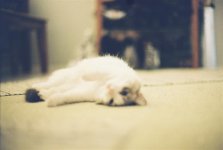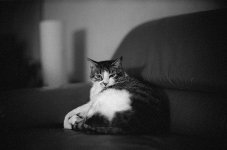mgilbuena
San Francisco Bay Area
I recently purchased a completely manual and lightmeterless M4-P. Coupled with a Nokton 50mm F/1.1 lens, I shot a test roll of Kodak Gold 200 and got the results back last night.
In low light conditions, I have found it extremely difficult to obtain correct focus. What techniques do you employ? Do you focus on the catch lights in the eyes? The point of the ears (in cats?)
Here's a picture of my cat that the focus was completely missed upon. Indoors, afternoon, shot at f/1.1 at 1/30
With the light being so dim, I found it hard to make out whether or not the nose was correctly aligned in the focus patch. What things do you guys look for, and what would you have looked for in the cat if you were taking this picture?
In low light conditions, I have found it extremely difficult to obtain correct focus. What techniques do you employ? Do you focus on the catch lights in the eyes? The point of the ears (in cats?)
Here's a picture of my cat that the focus was completely missed upon. Indoors, afternoon, shot at f/1.1 at 1/30
With the light being so dim, I found it hard to make out whether or not the nose was correctly aligned in the focus patch. What things do you guys look for, and what would you have looked for in the cat if you were taking this picture?



